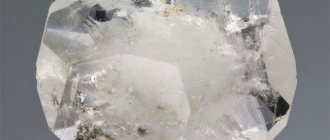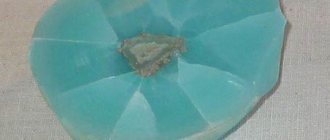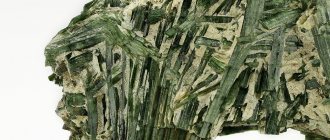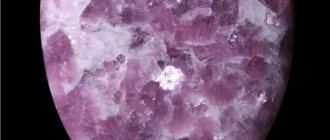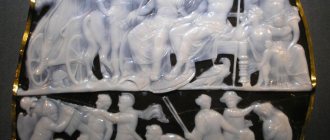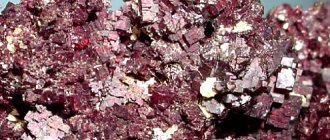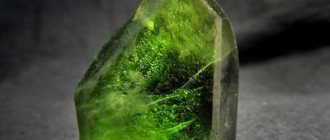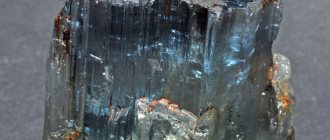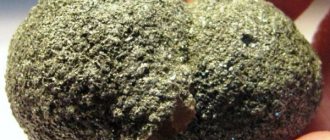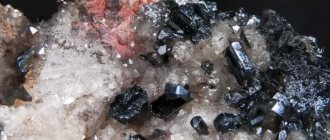| Category | Oxides (minerals) |
| Title in English | Rutile |
| Formula | TiO2 |
| Group | Oxides group |
| Color | Red, Brown |
| Stroke color | Brown |
| Shine | Diamond |
| Transparency | Translucent, Opaque |
| singonia | Tetragonal |
| Hardness | 6 — 6,5 |
| Cleavage | Perfect |
| Density, g/cm³ | 4,2 — 4,3 |
| Kink | Rough, Conchoidal |
| origin of name | The name is derived from the Latin word rutilus, which translates as “reddish”. |
Rutile is a fairly common mineral; it is one of the main sources of titanium. The stone is known for the variety of its unusual shapes: these are needle-like intergrowths created from thin crystals, and intergrowths of rutile threads, which permeate aggregates of other minerals, most often quartz and rock crystal. Such specimens are in incredibly high demand among collectors and become real highlights of mineralogical collections.
In its properties, rutile is similar to other polymorphs of titanium: brookite and anatase, but differs from the latter in its color palette, high stability and ability to be combined with a variety of minerals. In fact, rutile is a derivative of brookite and anatase: when exposed to high temperatures, both stones turn into rutile, the most thermally stable subtype.
What does the stone look like?
Typical rutile is those same shiny golden hairs-crystals inside another mineral (sapphire, spinel, ruby). But more often it is quartz with rutile or pure stone.
Quartz with rutile
The features of the crystal lattice give rise to the forms of the mineral - elongated prisms, hairs, needles, topped with a pyramid.
Physico-chemical characteristics
According to chemical nomenclature, the mineral rutile is titanium oxide with a standard formula for this class. Among the impurities are rare earth metals.
Anatase has the same formula. This is a rarer modification of titanium oxide with crystals of other shapes.
| Formula | TiO2 |
| Color | Black, brown, red, golden yellow |
| Stroke color | Grayish yellow to white |
| Shine | Diamond |
| Transparency | Translucent to fully opaque |
| Hardness | 6 — 7,5 |
| Cleavage | Average by {110}, imperfect by {100} |
| Density | 4.2 - 4.3 g/cm³ |
| singonia | Tetragonal |
Artificial production of the mineral.
It is obtained in the form of crystals during the decomposition of TiCl4 or TiF4 at a red-hot temperature; by melting TiO2 in borax, phosphorus salt or sodium tungstic acid (anatase can be obtained using the same methods, but at lower temperatures). It is formed during the aging of a colloidal solution of TiO2 obtained by hydrolysis from titanium salts. Rutile can also be obtained by heating anatase.
Diagnostic signs
Similar minerals. Magnetite, ilmenite, zincite, cassiterite, zircon, tourmaline, garnets (pyrope and almandine).
The crystals are characterized by a tetragonal shape and cranked twins. It differs from zircon in lower hardness, and from cassiterite in lower density. Acicular and hair-like rutile differs from tourmaline and goethite in the shape of the crystal cross-sections. In transparent sections, it differs from similar minerals in its exceptionally high refractive indices and birefringence (even in thin needles it gives high interference colors); reflected light is characterized by internal reflexes, high reflectivity, and the presence of doubles; cannot be etched.
Associated minerals. Quartz, amphibole, garnet, etc.
Place of Birth
The mineral is mined on almost all continents:
- America – Brazil, Canada, USA.
- Asia – Armenia, Kazakhstan, Uzbekistan.
- Europe – Austria, Italy, Norway, Switzerland.
- Russian deposits are concentrated in the Urals.
The mineral is found in rocks of igneous, sedimentary or hydrothermal origin. Often gold lies next to it.
Origin and location
Very common. Formed under various conditions. As an accessory mineral, it is found in igneous, metamorphic and sedimentary rocks, in small quantities in ores of various origins and compositions, in barren veins, and in massifs of secondary quartzites. It is observed in increased quantities in some pegmatites genetically related to the main rocks. It is widespread in metamorphic rocks: isolated grains in amphibolites (especially in the western Ore Mountains), gneisses, micaceous schists. Often forms needle-like inclusions in quartz, mica and other minerals (“Cupid’s arrows”, “hair of Venus”),
Mineral change.
Occasionally replaced by ilmenite.
Rutile. Segenit. Ural
Classification
The presence of impurities in the composition creates the following types of stone:
- Nigrin. Saturated with iron compounds, it looks like a black or dark brown agglomerate.
- Strueverit. The dominance of tantalum forms golden “hairs”.
- Ilmenorutil. Niobium creates yellow hairs. The second name is saguenite.
In pure rutile, the amount of impurities tends to zero.
Areas of use
Rutile is used by industrialists and appreciated by beauty enthusiasts.
Industry
The stone has found application in different directions:
- Its main importance is to be a source of the rare earth metals niobium and tantalum.
- Added to varnishes, paints, mixtures for making dishes.
- Raw materials for cosmetology. Cosmetics and perfumes are enriched with purified mineral to give them the ability to protect the skin from excess ultraviolet radiation.
“Rutilated” cookware breaks with difficulty and belongs to the premium price segment.
Jewelry
Jewelers purchase a pure variety of stone. It is framed in white gold and platinum.
Most pendants, pendants, and beads are rutile fragments in rock crystal.
Decor
The most popular decor and esoteric item are crystal balls with rutile fragments inside.
Craftsmen grind small plastic pieces, inserts for jewelry and other products.
Collecting
Collectors strive to acquire samples of unusual structure - twin, ternary, radiant. And also with a regular six-pointed star made of rutile in a gem.
History of rutile
— Advertising —
The first sample of rutile was discovered in the Central Urals, where naturalist Peter Simon Palace conducted geological and mineralogical expeditions. The scientist called the found gem “radiant schorl” because of the unusual optical effects of its crystal. In addition, the mineral was called "red sherpa", hair of Venus, cupid's arrow and shearling garnet. Only at the beginning of the 19th century, A. G. Werner studied this mineral in detail and gave it the name “rutile,” which goes back to the Latin “rutilus” and is translated as “reddish.” But even in modern mineralogy, such terms as “titanium scorl” and “titanium ore” continue to be used to name the mineral.
How to identify a fake
The stone is actively counterfeited. Most often it is glass.
There are several ways to spot a fake:
- Expose the sample to ultraviolet radiation (for example, place it in the sun). The hairs inside the stone will appear brownish red-yellow.
- Draw a line on the ceramics. In rutile it is gray, light brown, pastel yellow.
- There are no air bubbles inside the mineral.
You can distinguish it from other stones by weight: even the smallest rutile crystal is disproportionately massive .
The healing properties of rutile
Rutile has a positive effect on the functioning of the human respiratory system.
It is recommended for everyone who often suffers from respiratory diseases, chronic bronchitis, and bronchial asthma. Rutile is a prophylactic for complications such as sore throat, pneumonia and pleurisy. It exhibits protective properties for the lungs of those who smoke or are forced to stay in rooms with dirty air for a long time. Golden yellow and straw yellow colored specimens strengthen the immune system. Jewelry with them is recommended in case of illnesses and wounds that take a long time to heal. Yellow rutiles are also effective in removing toxins and radiation from the body. They have a positive effect on the liver, stomach, pancreas, improve appetite, normalize digestion and metabolism. An amulet with rutile in the groin area improves the functioning of the intestines, spleen and uterus.
Quartz water is made from rutile quartz. It is a structured biologically active liquid and has a rejuvenating effect and has a good effect on the cardiovascular system. Quartz water is also used externally to combat wrinkles and improve skin tone. Compresses with it are used in the treatment of acne, pimples and their marks. It helps in resolving bruises, strengthening blood vessels and improving complexion.
Stone care
The stone is moderately hard, but brittle. You need to take care of jewelry and collection material taking into account these properties of rutile:
- Select a box with soft inner lining for storage.
- Do not drop, avoid scratching or impacts.
- Protect samples from direct sun.
- Do not wear jewelry on the beach or summer walk. Take off before physical work, going to the gym, sauna, steam room.
Contaminants are removed with warm soapy water, then the products are immersed in highly diluted ammonia for a couple of seconds. After drying, put it in a box.
Links[edit]
- Handbook of Mineralogy.
- Web Mineral Data.
- mindat.org.
- Klein, Cornelis and Cornelius S. Hurlbut, 1985, Manual of Mineralogy, twentieth ed., John Wiley and Sons, New York, pp. 304-05, ISBN 0-471-80580-7.
- Hanaor, D. A. H.; Assadi, M. H. N.; Li, S.; Yu, A.; Sorrell, K. S. (2012). "Ab initio study of phase stability in doped TiO2". Computational Mechanics
.
50
(2): 185–94. arXiv: 1210.7555. Bibcode: 2012CompM..50..185H. DOI: 10.1007/s00466-012-0728-4. - Diebold, Ulrik (2003). "The Surface Science of Titanium Dioxide" (PDF). Surface Science Reports
.
48
(5–8): 53–229. Bibcode: 2003SurSR..48 … 53D. DOI: 10.1016/S0167-5729(02)00100-0. Archived from the original (PDF) on June 12, 2010. - "The Structure of Rutile" by Stephen Dutch, Natural and Applied Sciences, University of Wisconsin - Green Bay.
- Hanaor, Dorian AH; Xu, Wangqiang; Ferry, Michael; Sorrell, Charles S.; Sorrell, Charles K. (2012). "Anomalous growth of rutile TiO 2 grains caused by ZrSiO 4." Journal of Crystal Growth
.
359
: 83–91. arXiv: 1303.2761. Bibcode: 2012JCrGr.359…83H. DOI: 10.1016/j.jcrysgro.2012.08.015. - Magnetism in titanium dioxide polymorphs J. Applied Physics
Price
You can buy jewelry and collectibles on the Internet.
Price available (RUB):
- tumbling (1.5-3 cm) – 260-380;
- crystal (2x1.5 cm; in box) – 1,400;
- rutile (5.5x4.7x3.8) – 2,700;
- bracelet – 970-2 240;
- pendant – 1,200-1,400;
- beads – 1,300-6,300.
Almost all products and inserts are rutile in rock crystal.
Crystal structure[edit]
Unit cell of rutile. Ti atoms are gray; O atoms are red.
Extended crystal structure of rutile
Rutile has a tetragonal unit cell with unit cell parameters a
=
b
= 4.584 Å and
c
= 2.953 Å. [6] Titanium cations have a coordination number of 6, which means they are surrounded by an octahedron of 6 oxygen atoms. Oxygen anions have a coordination number of 3, which results in planar trigonal coordination. Rutile also shows the axis of the screw when its octahedra are considered sequentially. [7]
Rutile crystals are most often observed to exhibit a prismatic or needle-like growth habit with a predominant orientation along their c.
axes, [001] directions.
This growth pattern is favorable because the {110} facets of rutile have the lowest surface free energy and are therefore the most thermodynamically stable. [8] axis
-oriented growth of rutile appears clearly in nanorods, nanowires and anomalous grain growth phenomena of this phase.
The magical powers of the stone
The main property of rutile magic is to attract positivity to a person or home.
The influence of its soft energy is manifested in different areas:
- The owner becomes attractive to others. Which is useful when establishing business contacts or leading a team.
- A ring, pendant, or pendant with a round stone is recommended to be worn by people who want to start a family or a partner.
- A talisman or amulet cuts off external negativity, helps to survive emotional turmoil, and enjoy life again.
Constantly wearing a rutile talisman relieves depression, black thoughts, envy, and anxiety.
Practicing magicians prefer crystal balls with rutile. It enhances the magical properties of crystal, facilitating predictive rituals.
Zodiac signs
Rutile in jewelry and astrological talismans is most suitable for the zodiac signs Aquarius, Pisces, Cancer, Leo, Sagittarius, Libra, Gemini and Taurus.
- For Gemini and Libra, the power of the stone will help them discover new talents and opportunities, as well as constantly develop existing ones.
- Taurus and Aquarius will be able to feel peace of mind and self-confidence.
- Rutile will help Cancers get rid of the worries and doubts to which they are so susceptible.
- For Lviv and Sagittarius, the stone will teach you to care for others, which will have a positive impact on personal and family relationships.
- In Pisces, the power of the mineral will awaken passion, thanks to which the relationship with your loved one will become bright and emotional.
Astrologers do not recommend wearing rutile as a magical item for Aries.
The influence of the stone on the other signs of the zodiac has not been identified, either positive or negative. Back to contents

